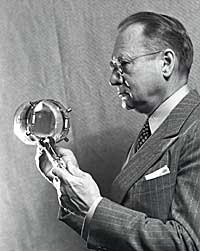Iconoscope: Difference between revisions
No edit summary |
(CSV import of Timeline data) |
||
| (11 intermediate revisions by 7 users not shown) | |||
| Line 1: | Line 1: | ||
[[Image:Zworykin.jpg|thumb|right|Vladimir Zworykin with an Iconoscope]] | |||
[[Image:Iconoscope patent diagram.jpg|thumb|right|Diagram of a UV microscope, similar in construction as an Iconoscope television camera tube. Filed with US Patent Office in 1931 by Vladimir Zworykin]] | |||
The iconoscope [from the Greek words "ikon" (image) and "skopion" (to look at)] was a new approach to [[Television|television]]—one that relied entirely on electronics rather than a combination of electronic and mechanical devices. | The iconoscope [from the Greek words "ikon" (image) and "skopion" (to look at)] was a new approach to [[Television|television]]—one that relied entirely on electronics rather than a combination of electronic and mechanical devices. [[Vladimir Zworykin|Vladimir Zworykin]] had the idea of projecting an image onto a special plate, which was covered with tiny dots of a chemical that is sensitive to light. In a sense, this broke up the image into thousands of picture elements or "pixels." Then, he swept an electron beam across the face of the plate, which had the effect of "charging" the pixels. After the electron beam swept past a pixel, the pixel retained an electric charge, which was then fed to the output of the camera. In this way, a visual image was converted to an electric signal without the need for heavy, rotating wheels as in previous television attempts that used variations of [[Nipkow Scanning Disk|Nipkow's disk]]. There had been other attempts to produce an all-electronic camera tube, but the Zworykin model was easier to manufacture and produced a very clear image. On 29 December 1923 Vladimir Zworykin filed a patent application on his Iconoscope, although the patent was not issued until 20 December 1938. | ||
When daily television broadcasts began in the late 1940s, the Zworykin tube was made obsolete by improved designs. One of its biggest shortcomings was the need for very bright lights in the television studio, which made the studios very hot places for actors to work. However, many of the basic concepts were retained, such as the use of a photosensitive plate and the scanning electron beam. | |||
[[Category:Communications]] | |||
[[Category:TV]] | |||
{{Timeline | |||
|Date=12/29/1923 | |||
|Priority=Electrical | |||
|Description=On 29 December 1923 Vladimir Zworykin filed for a patent on his Iconoscope TV Camera (issued 20 December 1938). It was a new approach to television that relied entirely on electronics rather than a combination of electronic and mechanical devices. Improved designs superseded it in the 1940s. | |||
}} | |||
{{Timeline | |||
|Date=12/29/1923 | |||
|Priority=Electrical | |||
|Description=On 29 December 1923 Vladimir Zworykin filed for a patent on his Iconoscope TV Camera (issued 20 December 1938). It was a new approach to television that relied entirely on electronics rather than a combination of electronic and mechanical devices. Improved designs superseded it in the 1940s. | |||
}} | |||
Latest revision as of 06:48, 23 November 2017
The iconoscope [from the Greek words "ikon" (image) and "skopion" (to look at)] was a new approach to television—one that relied entirely on electronics rather than a combination of electronic and mechanical devices. Vladimir Zworykin had the idea of projecting an image onto a special plate, which was covered with tiny dots of a chemical that is sensitive to light. In a sense, this broke up the image into thousands of picture elements or "pixels." Then, he swept an electron beam across the face of the plate, which had the effect of "charging" the pixels. After the electron beam swept past a pixel, the pixel retained an electric charge, which was then fed to the output of the camera. In this way, a visual image was converted to an electric signal without the need for heavy, rotating wheels as in previous television attempts that used variations of Nipkow's disk. There had been other attempts to produce an all-electronic camera tube, but the Zworykin model was easier to manufacture and produced a very clear image. On 29 December 1923 Vladimir Zworykin filed a patent application on his Iconoscope, although the patent was not issued until 20 December 1938.
When daily television broadcasts began in the late 1940s, the Zworykin tube was made obsolete by improved designs. One of its biggest shortcomings was the need for very bright lights in the television studio, which made the studios very hot places for actors to work. However, many of the basic concepts were retained, such as the use of a photosensitive plate and the scanning electron beam.
